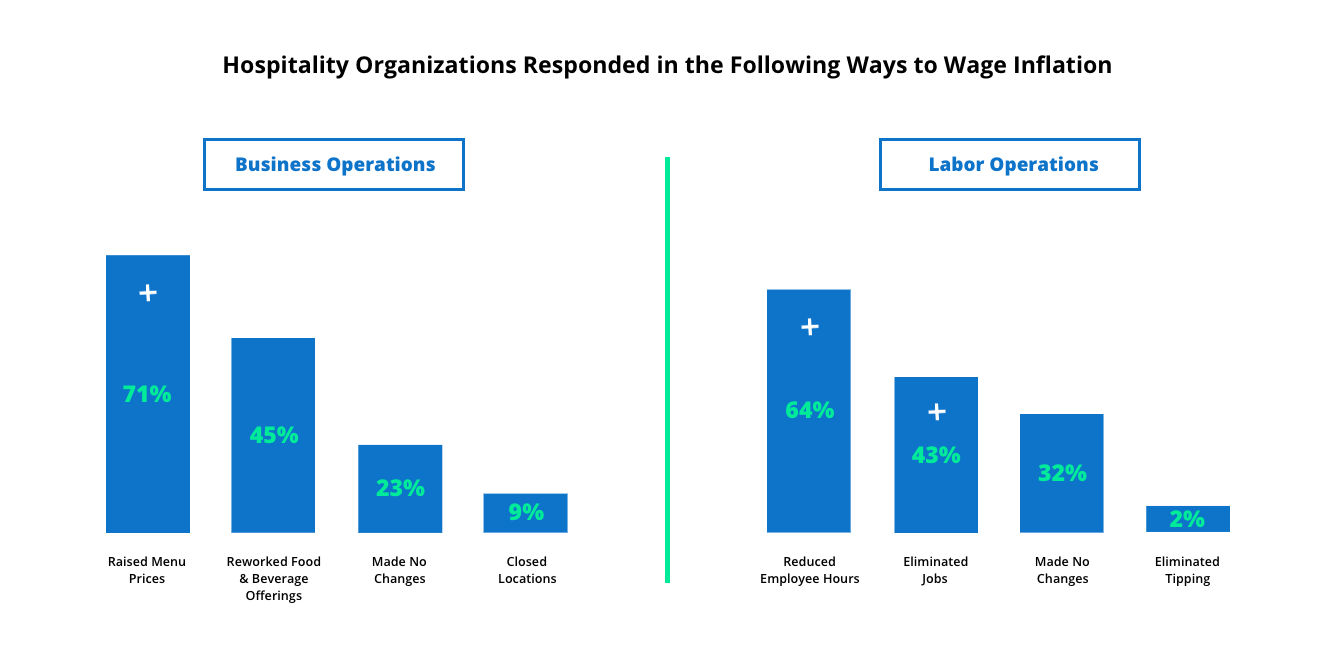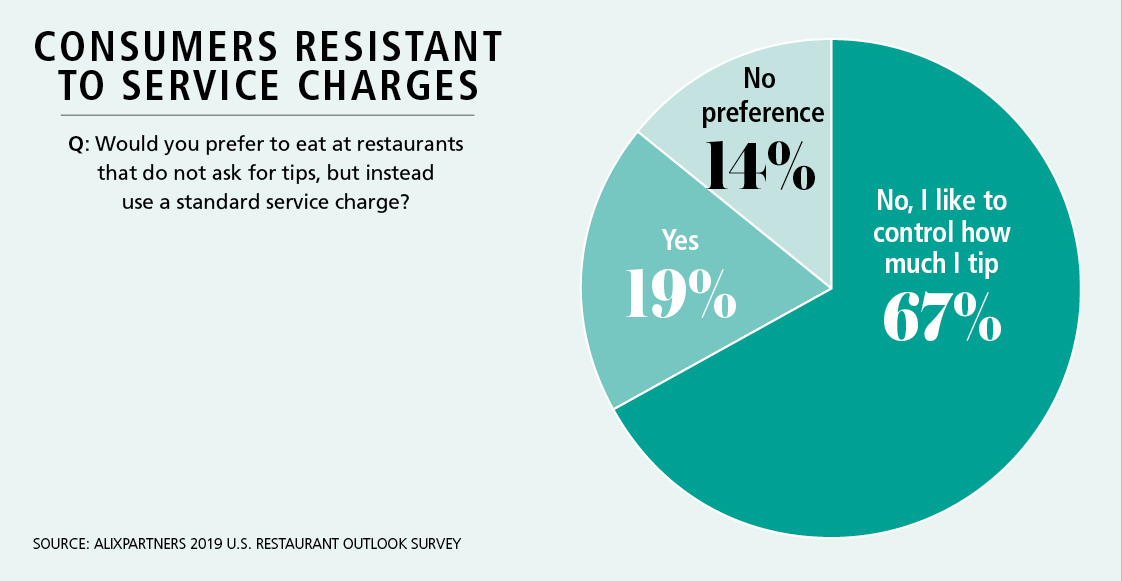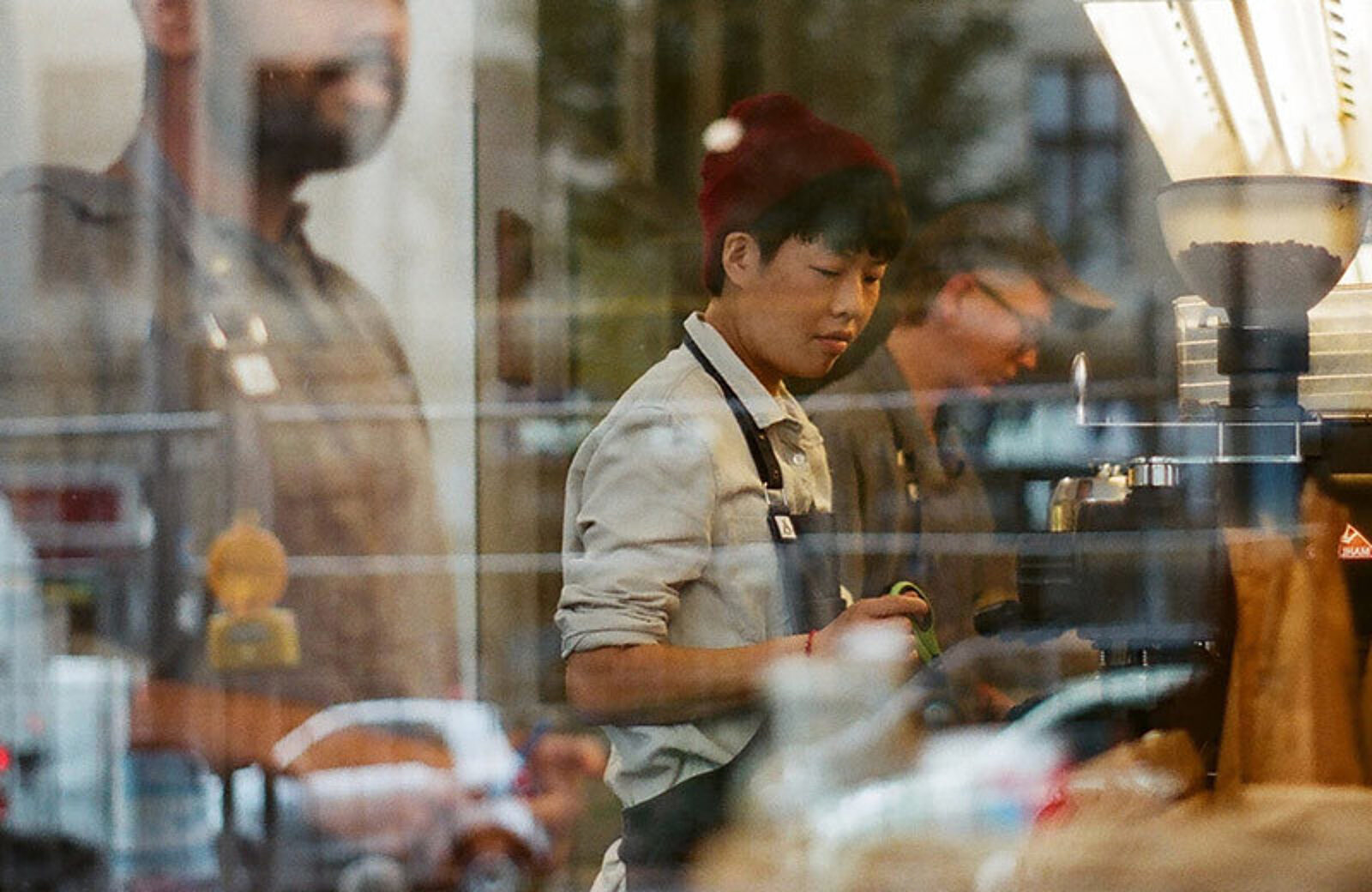How Restaurants are Dealing with Minimum Wage Increases

Nancy ShenkerAuthor
Welcome to 2020! To kick off the new year (and decade) 21 states and Washington, D.C have experienced increases to their minimum wage; another 4 states will see increases to their minimum wage later in the year, reports HR Dive.
Last year, 21 states and Washington, D.C. similarly saw increases in the minimum wage, according to Ballotpedia. Many of the states on the 2019 and 2020 lists are a part of a cohort experiencing incremental increases to their minimum wage over a 5 or 10 year period. The result: an abundance of restaurant closings, widespread job loss, and customer complaints about rising menu prices.
The restaurant industry has become synonymous with razor-thin margins and, as anticipated, these wage adjustments hit our industry especially hard. A study by Harri revealed that a whopping 71% of restaurants have responded to the recent minimum wage increases by raising menu prices.

In addition to price increases (71%), reduced employee hours (64%) and job eliminations (43%) were the most common reactions to wage inflation. According to the survey, 88% of restaurant operators gave a pay increase to non-minimum wage employees to close the gap, and 56% of non-minimum wage employees received increases of 5–15%.
Only time will tell whether higher menu prices will have a significant impact on consumers’ dining-out behaviors. With more people choosing to eat at home and the need to cut back on staff, restaurants need to find creative solutions to counteract wage increases beyond passing costs on to diners.
Tip Pooling Calculator
Use the Tip Pooling Calculator to learn how to distribute tips back to your restaurant’s employees using the tip pooling method.

Needless to say, this minimum wage increase was a significant hit to an industry that’s already struggling with low margins, fickle customers, and high staff turnover.
How Real Restaurants are Responding to the Minimum Wage Increase
John Banquil, CEO of Ling & Louie's Asian Bar and Grill, a four-location restaurant in three states, says, “We’ve had to take incremental menu price increases, worked with food and beverage distributors to secure better contract pricing, and adjusted our scheduling to be more efficient.”
Banquil believes that passing along costs to diners is not the only solution. In his 11 years of business experience, Banquil has seen the importance of employee satisfaction in driving business success. “We find it more important than ever to pay far above minimum wage for great employees. We need to maintain a great culture that ensures people love coming to work every day,” he continued.
“We find it more important than ever to pay far above minimum wage for great employees. We need to maintain a great culture that ensures people love coming to work every day."
John Banquil
CEO of Ling & Louie's Asian Bar and Grill
The Harri Survey revealed that 43% of restaurants are cutting jobs as a result of wage increases. Although some of these changes may result from streamlining operations, others are simply necessary for those restaurants to stay in business. Some states have been hit especially hard. New York City (where the minimum wage is $15) has experienced its sharpest decline in restaurant jobs in almost 20 years.
Making sudden or dramatic changes in staff roles or eliminating positions may result in short-term savings, but the Harri study indicates that these moves can result in increased employee turnover — by as much as 35%.
A recent survey of 324 full-service restaurants conducted by the New York City Hospitality Alliance found that cutting hours was the prevailing repercussion of the minimum wage increase in the NYC area, followed by job cuts.
Full Service Restaurants
In response to the minimum wage, tip wage, and minimum salary requirements increasing in New York City on December 31, 2018, full service restaurant respondents will adjust their restaurant(s) business operations in the following ways in 2019.
Restaurateurs are actively searching for an option that allows them to hold onto their best employees and cover the increased labor overhead without compromising the quality of their dining experience – so far, there isn’t a clear winner.
3 Alternatives to Increasing Menu Prices to Offset High Labor Costs
Only 2% of the restaurants polled in the Harri study eliminated tipping as a means of dealing with minimum wage hikes. No-tipping policies have been adopted in markets like New York, where the minimum wage is up to $15, but, according to Grub Street, both diners and restaurant employees have balked at this new approach. Customers want to be able to reward high-quality service, and top-performing restaurant talent have grown accustomed to being acknowledged for their abilities.
A recent restaurant satisfaction survey conducted by AlixPartners found that 67% of respondents dislike automatic service charges, one of the most common tactics restaurants are using to offset mounting labor overhead.
Here’s where it gets interesting: When asked whether they support an increased minimum wage, 59% of respondents were in favor; 64% stated they would be willing to pay more as a result. However, when asked about the factors that may deter dining out in the year ahead, 49% said they were planning to put their money toward something other than going out to eat, and 30% believe meals at a restaurant are too expensive as is.
So, it seems, restaurant diners are in a bit of a catch-22: They believe front-of-house restaurant staff should be paid more for their hard work and, in theory, would support higher meal prices, but when the bill comes, they aren't comfortable with what they see. So much so that they may just stay home and save their pennies for something else.
Sadly, about 1 in 10 restaurants say that closing locations has been the only solution to wage increases.
Boston landmark Durgin Park (founded in 1827) cited labor costs as the reason for its closure, and a Harvard Business School study indicated that restaurants that were already experiencing service or popularity issues had a higher likelihood of going under if the minimum wage went up in their area.
Matias Pesce, CEO of the V & E Restaurant Group, oversees 60 restaurants in Miami, Mexico City, and Las Vegas. With 34 years of experience in the industry, he stressed that labor costs will ultimately have an impact on the customer experience – whether through increased menu prices or diminished service. He believes strongly that service quality and employee satisfaction are crucial in the face of wage increases.
Matias asserts, “We have a great working relationship with our team members and a very good understanding of our guest count trends… We did not have to make adjustments to employee hours or price increases to offset the [minimum wage] impact. We understand a modest increase improves worker productivity and reduces employee turnover and absenteeism as well.”
"We did not have to make adjustments to employee hours or price increases to offset the [minimum wage] impact. We understand a modest increase improves worker productivity and reduces employee turnover and absenteeism as well.”
Matias Pesce
CEO of the V & E Restaurant Group
How to Stay One Step Ahead of the Minimum Wage Increase Effects
Rising labor costs can be beyond your control, but taking a proactive approach and adjusting your response plan can help minimize their impact on your restaurant's health. Here are some ways restaurant owners can successfully offset increased labor overhead.
Be creative in your menu pricing.
Your menu prices should balance customer spending habits and preferences, market research, and competitive intel, all while offsetting operational costs in your restaurant. Your menu's design and layout also has an impact on customer perception.
If you're raising your prices, now is a good time to evaluate how you present your selections to customers. To get started on the journey to mastering menu pricing, sign up for Toast's free Menu Engineering Bootcamp.
Adapt your scheduling strategy.
Carefully tracking your labor costs and creating schedules around peak sales times is key to controlling labor expenses. You can create a scheduling strategy based on sales data that'll also keep your servers happy.
Restaurant Scheduling Template
Use the Restaurant Scheduling Template to easily schedule your restaurant staff's shifts.

Hire the right people.
If you employ workers with a can-do attitude and a range of skills, they'll be able to pick up the slack if you need to downsize your team. Knowing how to interview, cross-train, and build a strong culture is more important than ever.
If you need to consolidate positions, do it mindfully and get feedback from your team throughout the process. Operating with fewer people means you need to be more selective in looking for talent. According to the Harri study, turnover increased by 35% when positions and hours were cut due to wage increases. If you're stuck in a hiring rut, take this interactive course – Hiring the Modern Restaurant Workforce – for in-depth insights and actionable advice related to the restaurant hiring cycle.
Stay closer than ever to staff and customer sentiment.
Customer feedback is vital to the success of any business. This is especially true in the restaurant industry. Consistently solicit and collect feedback from your guests via all channels possible. Read Facebook and Instagram comments, keep close tabs on your Yelp or TripAdvisor page, and send out surveys periodically using your restaurant CRM platform.
Restaurants that use Toast can now access customer feedback in real time using the guest feedback feature. During the payment process, guests are prompted to rate their experience and leave comments for the staff. Should a poor rating be recorded, restaurant management is instantly alerted via text message, giving them the opportunity to connect with guests and learn how their restaurant can improve for next time.
Invest in tech.
In recent years, restaurant technology has evolved to take the stress out of running a restaurant. Handheld point of sale technology can be a big help for restaurants in a tough labor market. Teams that incorporate handheld payment products into their restaurant operations have found they increase server tips and decrease turnover. They can also help to onboard new staff members quickly with notes about menu items, ingredient info, and wine pairings, and can turn tables faster by cutting out the time spent walking between the table and the terminal.
Monitor local and national legislation.
This may impact your future costs, and be proactive in finding solutions. These simple charts from the Department of Labor can help you monitor the minimum wage in your area and prepare for any upcoming increases. If you aren't already, becoming active in your local and national restaurant associations or attending industry events like Food for Thought will help you learn from others in the industry who are facing the same challenges.
Related Restaurant Resources
Is this article helpful?
DISCLAIMER: This information is provided for general informational purposes only, and publication does not constitute an endorsement. Toast does not warrant the accuracy or completeness of any information, text, graphics, links, or other items contained within this content. Toast does not guarantee you will achieve any specific results if you follow any advice herein. It may be advisable for you to consult with a professional such as a lawyer, accountant, or business advisor for advice specific to your situation.





